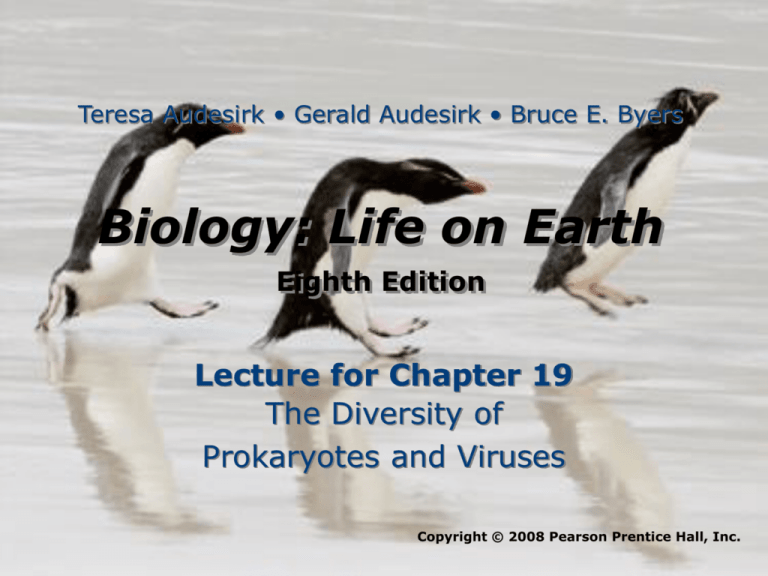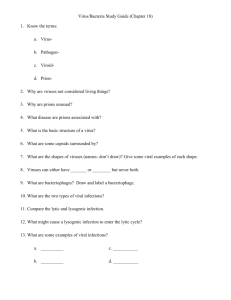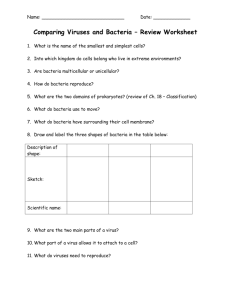
Teresa Audesirk • Gerald Audesirk • Bruce E. Byers
Biology: Life on Earth
Eighth Edition
Lecture for Chapter 19
The Diversity of
Prokaryotes and Viruses
Copyright © 2008 Pearson Prentice Hall, Inc.
Chapter 19 Outline
• 19.1 Which Organisms Make Up the Prokaryotic
Domains—Bacteria and Archaea? p. 372
• 19.2 How Do Prokaryotes Survive and
Reproduce? p. 373
• 19.3 How Do Prokaryotes Affect Humans and
Other Eukaryotes? p. 376
• 19.4 What Are Viruses, Viroids, and Prions? p.
379
Section 19.1 Outline
• 19.1 Which Organisms Make Up the Prokaryotic
Domains—Bacteria and Archaea?
– Bacteria and Archaea Are Fundamentally
Different
– Classification of Prokaryotes Within Each
Domain Is Difficult
– Prokaryotes Differ in Shape and Structure
Prokaryotic Domains
• Evolutionists believe Earth’s first
organisms were prokaryotes, single-celled
microbes that lacked organelles
• Prokaryotes are still abundant, comprising
two of life’s three domains
– Bacteria
– Archaea
Classifying Prokaryotes Is Difficult
• Prokaryotes are structurally simple
• No easily observed anatomical or
developmental differences (as in animals)
Classifying Prokaryotes Is Difficult
• Features used in prokaryotic classification:
– Shape
– Means of locomotion
– Pigments
– Nutrient requirements
– Colony appearance
– Gram staining characteristics
– Nucleotide sequences
Different Sizes and Shapes
• Three Common Shapes
– Spherical (cocci)
– Rodlike (bacilli)
– Corkscrew-shape (spirilla)
Section 19.2 Outline
• 19.2 How Do Prokaryotes Survive And
Reproduce?
– Some Prokaryotes Are Mobile
– Many Bacteria Form Films on Surfaces
– Protective Endospores Allow Some Bacteria to
Withstand Adverse Conditions
– Prokaryotes Are Specialized for Specific Habitats
Section 19.2 Outline
• 19.2 How Do Prokaryotes Survive And
Reproduce? (continued)
– Prokaryotes Exhibit Diverse Metabolisms
– Prokaryotes Reproduce by Binary Fission
– Prokaryotes May Exchange Genetic Material
Without Reproducing
Prokaryotic Adaptations
• Prokaryotic adaptations enable success in
a wide variety of environments
Mobile Prokaryotes
• Some prokaryotes are mobile
• Means of locomotion: flagella
– Found singly, in pairs, at different locations
– In bacteria, a "wheel-and-axle" arrangement
anchors the flagellum within the cell wall and
plasma membrane, enabling the flagellum to
rotate rapidly
FIGURE 19-2b The prokaryote flagellum
(b) In bacteria, a unique "wheel-and-axle" arrangement anchors the flagellum
within the cell wall and plasma membrane, enabling the flagellum to rotate
rapidly.
Biofilms
• Some bacteria secrete sticky layers of
polysaccharide (carbohydrate) or protein
slime
• Aggregates (communities) of slimesecreting bacteria are called biofilms
– Dental plaque is a biofilm
• Bacteria embedded in biofilms are
protected from disinfectants and antibiotics
FIGURE 19-3 The
cause of tooth decay:
Bacteria in the human
mouth form a slimy
biofilm that helps
them cling to tooth
enamel and protects
them from threats in
the environment. In
this micrograph,
individual bacteria
(colored green or
yellow) are visible,
embedded in the
brown biofilm. The
bacteria-laden biofilm
can cause tooth
decay.
Bacterial Endospores
• Endospores form inside some bacteria
under inhospitable environmental
conditions (survival mechanism)
• Endospores are thickly-wrapped particles
of genetic material and a few enzymes –
but enough to reproduce and create new
bacteria when more favorable conditions
‘return’
Bacterial Endospores
• Endospores are resistant to extremes
– Survival in boiling water
– Stable and long-lived (> 250 million years)
– Ideal bioterror agent (e.g. anthrax spores)
FIGURE 19-4 Spores protect some bacteria
Resistant endospores have formed inside bacteria of the genus Clostridium,
which causes the potentially fatal food poisoning called botulism.
Habitat Specialization
• Each species is specialized for certain
environmental conditions
• Prokaryotes occupy a wide range of habitats
Habitat Specialization
• Prokaryote habitats
– High pressure environments (1.7 miles
underground)
– Cold environments (Antarctic sea ice)
– High salt environments (Dead Sea)
– Acidic or alkaline environments (coal mine
drainage)
– Moderate environments (the human body)
– Hot environments (deep-sea vents, hot springs)
FIGURE 19-5 Some prokaryotes thrive in extreme conditions:
Hot springs harbor bacteria and archaea that are both heat and
mineral tolerant. Several species of cyanobacteria paint these hot
springs in Yellowstone National Park with vivid colors; each is
confined to a specific area determined by temperature range.
Diverse Metabolisms
• Anaerobic Metabolism
– Some bacteria live without oxygen (and are
poisoned by it)
• e.g. Tetanus bacteria
– Some bacteria can switch between aerobic
(metabolism with O2) and anaerobic
respiration (metabolism without O2)
• e.g. Escherichia coli in our large intestines
Diverse Metabolisms
• Where bacteria get their energy (wide variety)
– Familiar organic compounds
• Sugars, carbohydrates, fats, and proteins
– Compounds poisonous to humans
• Petroleum, methane, benzene, toluene
– Inorganic molecules
• Hydrogen, sulfur, ammonia, iron, nitrite
Diverse Metabolisms
• Some bacteria get energy from sunlight
– Cyanobacteria perform photosynthesis
– Sulfur bacteria use H2S instead of water in
photosynthesis
FIGURE 19-6 Cyanobacteria
Electron micrograph of a section through a cyanobacterial filament.
Chlorophyll is located on the membranes visible within the cells.
Binary Fission
• Asexual cell division produces identical
copies (bacterial reproduction = asexual)
• Binary fission can occur every 20 minutes
• Rapid reproductive rate allows for rapid
evolution
– Mutations in DNA replication are rapidly
spread
FIGURE 19-7 Reproduction in prokaryotes
Prokaryotic cells reproduce by binary fission. In this color-enhanced
electron micrograph, an Escherichia coli, a normal component of the
human intestine, is dividing. Red areas are genetic material.
Exchange of Genetic Material
• Conjugation allows for DNA transfer
between donor and recipient
• Sex pilus connects donor to recipient cell
forming a cytoplasmic bridge
• Conjugation can occur between different
species
• Small circular DNA molecules (plasmids)
carry genes from donor to recipient
FIGURE 19-8 Conjugation: Prokaryotic "mating”
During conjugation, one prokaryote acts as a donor, transferring DNA to the
recipient. In this photo, two Escherichia coli are connected by a long sex pilus.
The sex pilus will retract, drawing the recipient bacterium (at right) to the donor
bacterium. The donor bacterium is bristling with non-sex pili that help it attach to
surfaces.
Section 19.3 Outline
• 19.3 How Do Prokaryotes Affect
Humans and Other Eukaryotes?
– Prokaryotes Play Important Roles in Animal
Nutrition
– Prokaryotes Capture the Nitrogen Needed by
Plants
– Prokaryotes Are Nature’s Recyclers
– Prokaryotes Can Clean Up Pollution
– Some Bacteria Pose a Threat to Human
Health
Role in Nutrition
• Leaf-eating animals depend on bacteria to
break down cellulose (e.g. rabbits, cattle)
• Many human foods are produced by
bacteria action (e.g. cheese and yogurt)
• Bacteria in our intestines produce vitamins
(e.g. vitamins K and B12)
Nitrogen Fixation
• Nitrogen is unavailable to plants as a gas
• Nitrogen fixing bacteria convert
atmospheric N2 (gas) to water-soluble
NH4+ (ammonium) in the soil – this is an
incredibly important process
• Nitrogen fixers sometimes live in
specialized root nodules (rhizomes)
– Found in alfalfa, soybeans, lupines, clover
FIGURE 19-9a Nitrogenfixing bacteria in root
nodules
(a) Special chambers called
nodules on the roots of a
legume (alfalfa) provide a
protected and constant
environment for nitrogenfixing bacteria.
Nature’s Recyclers
• Many prokaryotes obtain energy by
breaking down organic molecules including
those in waste products and dead bodies
of plants and animals
• Decomposition of dead organisms frees
nutrients for reuse by new life
Clean Up Pollution
• Nearly all human-made substances (save
plastic) are biodegradable by some
bacterial species
• Oil-eating bacteria were used in clean up
of Exxon Valdez oil-spill disaster
Threat to Human Health
• Disease-producing bacteria are
pathogenic
• Some anaerobic bacteria produce
dangerous poisons:
– Clostridium tetani causes tetanus
• Enters body through puncture wound
• Produces paralyzing poison
– Clostridium botulinum causes botulism
• Reproduces in under-sterilized canned food
• Botulism toxin is very potent
Threat to Human Health
• Humans have battled bacterial diseases
throughout history
• Bubonic Plague (Black Death)
– Caused by Yersinia pestis and spread by rat
fleas
– Killed 100 million people in the 1300s
• Lyme Disease (emerged in 1975)
– Caused by spiral-shaped Borrelia burgdorferi
– Carried by deer ticks which bite humans
– Flu-like symptoms can lead to arthritis and heart
and nervous system problems
Threat to Human Health
• Other historical bacterial diseases
disappear and then reoccur
– Tuberculosis (once thought to be vanquished
from the United States)
– Gonorrhea and syphilis (sexually transmitted)
– Cholera (water-transmitted in contaminated
drinking water)
Common Harmful Bacterial Species
• Streptococcus bacteria
– Cause strep throat, pneumonia, necrotizing
fasciitis
• Escherichia coli
– Common inhabitants of digestive system
– O157:H7 E. coli strain is pathogenic
• Transmitted through undercooked hamburger
• Causes intestinal bleeding and can be fatal
Most Bacteria Are Harmless
• The majority of bacteria are harmless
• Bacterial communities can be beneficial
– Create environment hostile to pathogenic
infection in vaginal tract
– Produce vitamin K in our intestines
Section 19.4 Outline
• 19.4 What Are Viruses, Viroids, and
Prions?
– A Virus Consists of a Molecule of DNA or
RNA Surrounded by a Protein Coat
– Some Infectious Agents Are Even Simpler
Than Viruses
– No One Is Certain How These Infectious
Particles Originated
Viruses
• Characteristics of a virus
– No cell membrane , no cytoplasm, no
ribosomes – not a living thing
– Can only reproduce inside a host cell
– Very small size (0.05-0.2 micrometers)
– Come in a variety of shapes
FIGURE 19-10 The sizes of microorganisms
The relative sizes of eukaryotic cells, prokaryotic cells, and
viruses (1 μm = 1>1000 millimeter). Viruses are tiny!
FIGURE 19-11 (part 1 & 2) Viruses come in a variety of shapes.
Viral shape is determined by the nature of the virus's protein coat.
Viruses
• Two major components constitute a virus
– Single or double-stranded DNA, or singlestranded RNA as hereditary material
– Protein coat
• May be surrounded by an envelope formed from
the plasma membrane of the host cell
• Essentially sends a message to the next host cell
that says ‘let me in’
FIGURE 19-12 Viral
structure and replication
A cross section of the virus
that causes AIDS. Inside,
genetic material is
surrounded by a protein
coat and molecules of
reverse transcriptase, an
enzyme that catalyzes the
transcription of DNA from
the viral RNA template
after the virus enters the
host cell. This virus is
among those that also
have an outer envelope
that is formed from the host
cell's plasma membrane.
Spikes made of
glycoprotein (protein and
carbohydrate) project from
the envelope and help the
virus attach to its host cell.
Viruses
• Cannot grow or reproduce on their own
and are parasites of living cells
• Have a specialized protein coat that
enables entry into a host cell…
• Viral genetic material “hijacks” host cell to
produce new viral components
• Viral components assemble rapidly into
new viruses and burst from host cell
Viruses Are Host-Specific
• Each viral type specialized to attack
specific host cell
• Bacteria are infected by bacteriophage
viruses
FIGURE 19-13 Some viruses infect bacteria
In this electron micrograph, bacteriophages are attacking a bacterium. They’ve
injected their genetic material inside, leaving their protein coats clinging to the
bacterial cell wall. The black objects inside the bacterium are newly forming
viruses.
Viruses Are Host-Specific
• Bacteriophages can treat bacterial diseases
– Rise in bacterial antibiotic resistance makes
standard drugs less effective
– Bacteriophages specifically target host bacteria
– Bacteriophages are harmless to human body
cells
Viruses Are Host-Specific
• In multicellular organisms viruses
specialize in attacking particular cell types
• Cold viruses attack membranes of
respiratory tract
• Measles viruses infect the skin
• Rabies viruses attack nerve cells
Viruses Are Host-Specific
• Some viruses linked to cancer (e.g. T-cell
leukemia, liver cancer, cervical cancer)
• Herpes virus attacks mucous membranes
of mouth and lips (causing cold sores)
– Other herpes virus type causes genital
sores
• HIV virus attacks specific white blood cell
type, causing AIDS
Viral Infections Are Difficult to Treat
• Antibiotics against bacteria are ineffective
against viruses
• Antiviral drugs may also kill host cells
• Viruses “hide” within cells, are hard to
detect
Viral Infections Are Difficult to Treat
• Viruses have high mutation rates
– Mutations can confer resistance to antiviral
drug
– Resistant viruses spread and multiply,
rendering drug ineffective
Viruses as Biological Weapons
• Difficulty in treating viral infections makes
viruses devastating weapons
• Limited smallpox stocks saved to develop
future vaccine against unknown stocks
• Ebola hemorrhagic fever kills 90% of
victims (no treatment or vaccine known)
Viroids
• Viroids are infectious particles with only
short RNA strands (no protein coat)
• Able to enter host cell nucleus and direct
new viroid synthesis
• A number of crop diseases are caused by
viroids
– e.g. cucumber pale fruit disease, avocado
sunblotch, potato spindle tuber disease
Prions
• Fatal degenerative disease discovered in
New Guinea tribe (Fore) in 1950
• Kuru causes loss of coordination,
dementia, death
• Kuru in the Fore tribe was transmitted by
ritual cannibalism of the dead
Prions
• Other diseases like kuru include:
– Creutzfeldt-Jacob (CJD) disease in humans
– Scrapie in sheep
– Bovine spongiform encephalopathy (BSE
or “Mad Cow Disease”) in cattle
• These diseases create holes in brain
tissue
Prions
• Scrapie, CJD, kuru caused by infectious
protein particle (Stanley Prusiner, Nobel
Prize 1982)
• Prion-caused diseases may be heritable
FIGURE 19-14 Prions:
Puzzling proteins
A section from the brain of
a cow infected with bovine
spongiform
encephalopathy contains
fibrous clusters of prion
proteins.
Proposed Replication of Prions
1. Prion protein a normal part of nerve cells
2. Misfolded versions are the infectious
particles
3. Misfolded proteins induce normal copies
to misfold too
4. High concentration of prions in nerve
tissue causes cell damage and
degeneration
Origin of Infectious Particles?
• Evolutionary remnants of life’s early
history?
– Self-replicating mechanisms similar to
proposed pre-DNA world)
• Degenerate descendants of parasitic cells?
– Ancient parasites may have become dependent
on hosts biochemical machinery









